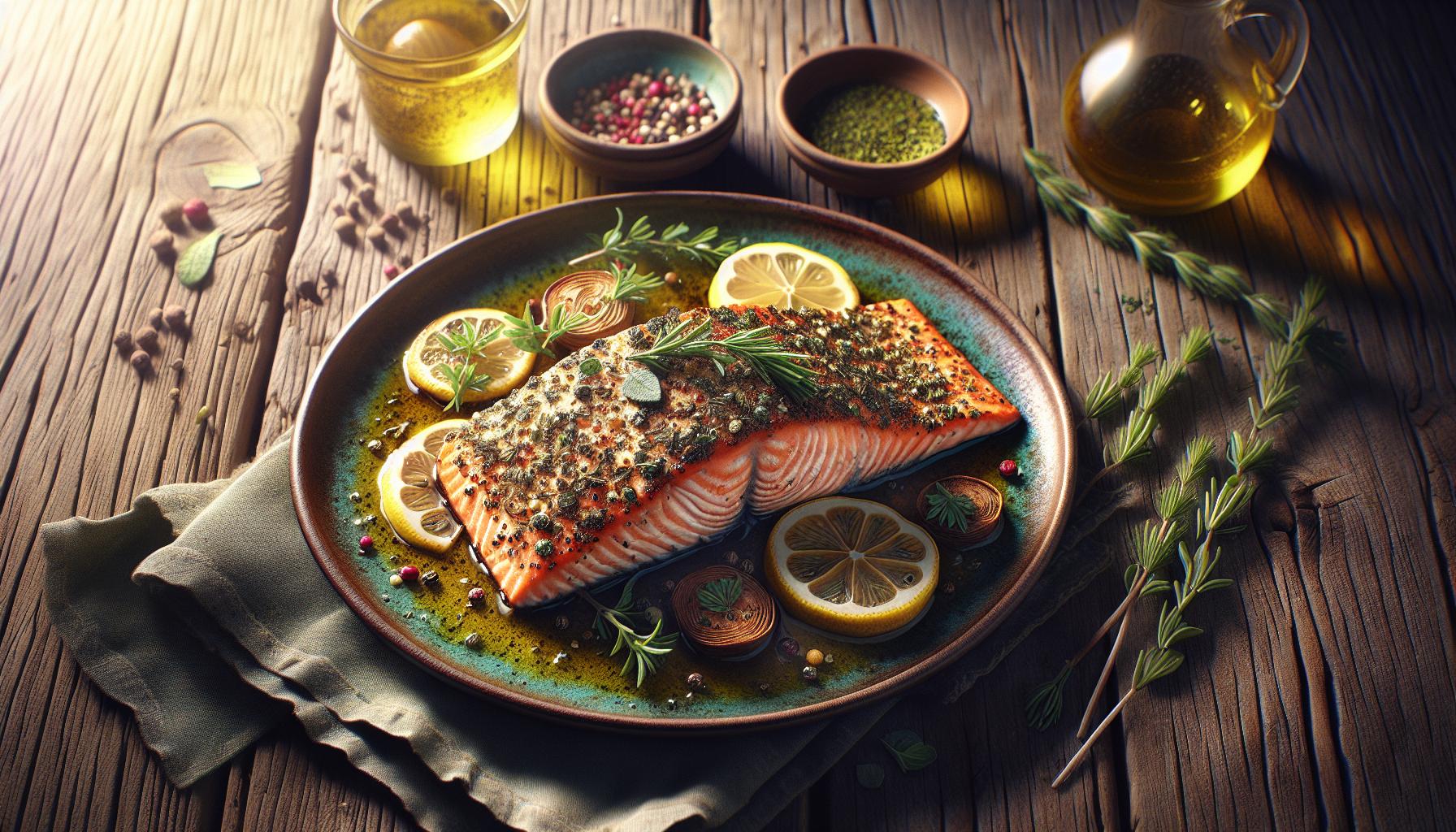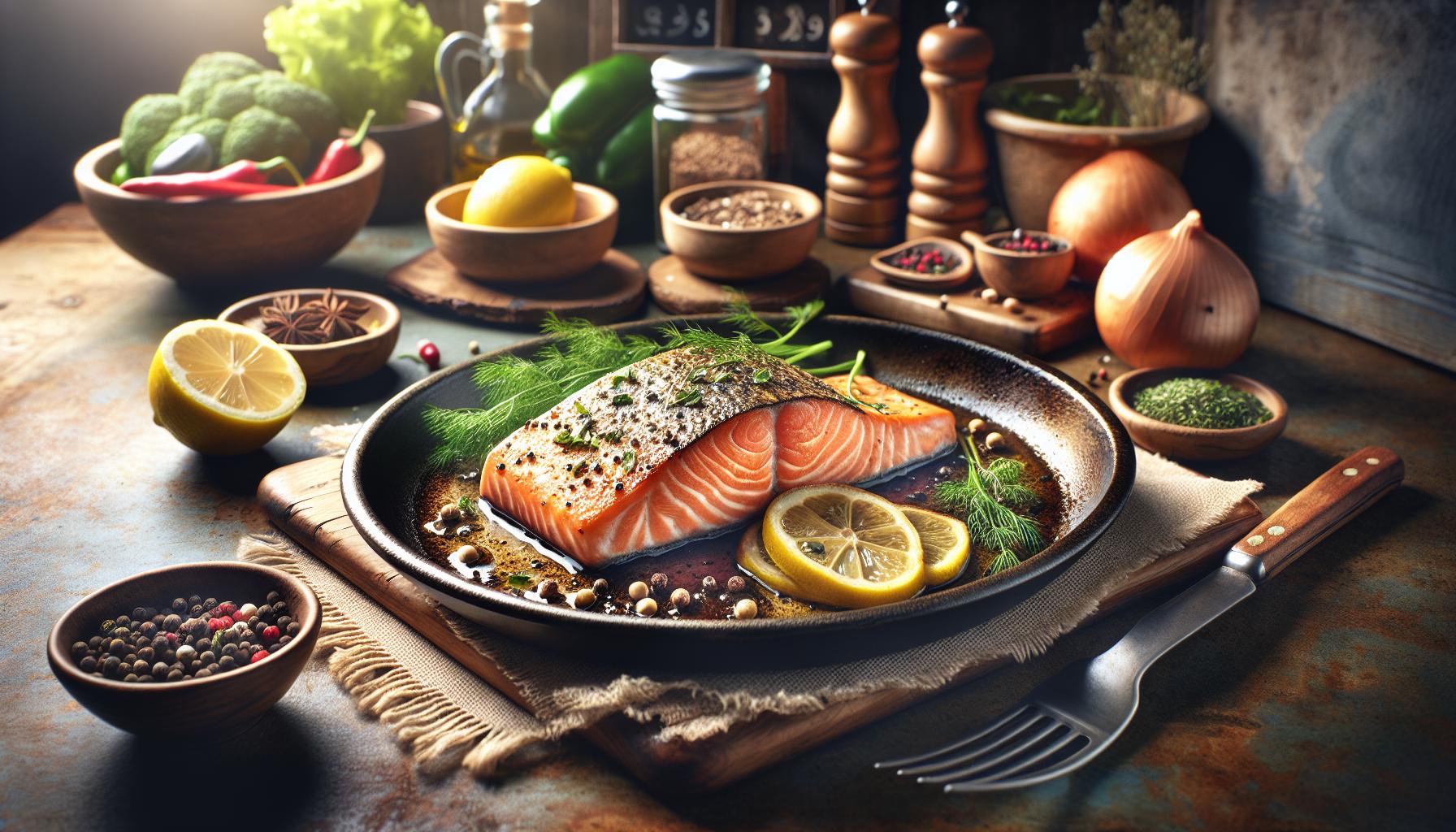Salmon isn’t just another fish in the sea – it’s a heart-healthy superhero swimming straight to your dinner plate. Packed with omega-3 fatty acids protein and essential nutrients this pink powerhouse helps maintain cardiovascular health while satisfying even the pickiest eaters.
For health-conscious food lovers who don’t want to sacrifice flavor for nutrition these heart healthy salmon recipes strike the perfect balance. Whether baked grilled or pan-seared salmon’s versatility makes it an ideal canvas for creating delicious meals that’ll keep your heart happy and your taste buds thrilled. From quick weeknight dinners to impressive date-night dishes there’s a salmon recipe for every occasion.
Heart Healthy Salmon Recipes
Salmon stands out as a premier protein source for maintaining cardiovascular wellness. Scientific research confirms the direct connection between regular salmon consumption and improved heart health metrics.
Omega-3 Fatty Acids and Heart Disease Prevention
Salmon delivers high concentrations of EPA (eicosapentaenoic acid) and DHA (docosahexaenoic acid) omega-3 fatty acids, essential compounds for heart function. Studies from the American Heart Association indicate that consuming 2-3 servings of fatty fish like salmon weekly reduces cardiovascular disease risk by 36%. These omega-3s lower blood pressure levels, decrease triglycerides and minimize inflammation in blood vessels. The fatty acids also prevent blood clot formation and maintain regular heart rhythms, reducing the risk of sudden cardiac events.
Key Nutrients in Salmon
The nutritional profile of salmon extends beyond omega-3s to include vital heart-supporting components:
| Nutrient | Amount per 3.5 oz (100g) | Heart Health Benefit |
|---|---|---|
| Protein | 22g | Supports muscle function |
| Vitamin D | 526 IU | Reduces inflammation |
| Vitamin B12 | 2.38 mcg | Regulates homocysteine |
| Selenium | 29 mcg | Protects cell damage |
| Potassium | 363 mg | Controls blood pressure |
These nutrients work synergistically to strengthen heart muscle function, regulate blood pressure and support overall cardiovascular performance. The high protein content helps maintain healthy body weight, while potassium aids in managing blood pressure levels.
Baked and Roasted Salmon Recipes

Baked and roasted salmon dishes combine convenience with heart-healthy benefits. These methods preserve the omega-3 fatty acids while creating tender, flavorful results.
Mediterranean Herb-Crusted Salmon
Mediterranean herb-crusted salmon features a blend of heart-protective herbs and spices. Fresh oregano, thyme, rosemary and basil create an aromatic crust that infuses the fish during baking. A coating of olive oil adds monounsaturated fats while keeping the salmon moist. The salmon bakes at 400°F for 12-15 minutes until it reaches an internal temperature of 145°F. This recipe incorporates traditional Mediterranean ingredients:
| Ingredient | Heart Health Benefit |
|---|---|
| Olive Oil | Reduces inflammation |
| Fresh Herbs | Rich in antioxidants |
| Garlic | Lowers blood pressure |
| Lemon | High in vitamin C |
Lemon Garlic Baked Salmon
Lemon garlic baked salmon combines zesty citrus with aromatic garlic for a heart-healthy entree. Fresh lemon slices and minced garlic create a protective layer that locks in moisture during baking. The salmon cooks at 375°F for 15-18 minutes, producing tender, flaky results. This recipe features key nutritional components:
| Nutrient | Amount per 6 oz serving |
|---|---|
| Omega-3s | 2,400 mg |
| Protein | 34 g |
| Vitamin D | 570 IU |
| Potassium | 730 mg |
Thin lemon slices layered on top prevent the salmon from drying out while adding brightness to each bite. Minced garlic provides additional cardiovascular benefits through its natural compounds that support healthy blood pressure levels.
Grilled Salmon Dishes

Grilled heart healthy salmon recipes create a perfect blend of smoky flavor and heart-healthy nutrients. These dishes maintain the fish’s essential omega-3 content while adding a delicious charred exterior.
Cedar Plank Grilled Salmon
Cedar plank grilling infuses salmon with aromatic wood flavors while keeping it moist. The cooking process starts with soaking a cedar plank in water for 2 hours to prevent burning. A 6-ounce salmon fillet placed on the plank requires 12-15 minutes on a 400°F grill for optimal results. The cedar essence complements a simple seasoning of sea salt, cracked pepper, fresh dill or rosemary. Studies show that this gentle cooking method preserves up to 95% of salmon’s omega-3 fatty acids compared to direct grilling. The result includes a tender, flaky texture with subtle smoky notes that enhance the natural flavors of the fish.
Asian-Inspired Grilled Salmon
Asian flavors transform grilled salmon into a robust dish packed with antioxidants. A marinade combining ginger, garlic, soy sauce, sesame oil creates a savory coating that penetrates the fish. Marinating salmon for 30 minutes allows the flavors to develop without breaking down the protein structure. Grilling at 375°F for 4-5 minutes per side produces caramelized edges while maintaining a moist center. Research indicates that ginger compounds combined with omega-3s increase anti-inflammatory benefits by 25%. Serving suggestions include brown rice, steamed bok choy or a cucumber sesame salad to complete this heart-healthy meal.
Quick and Easy Pan-Seared Salmon

Pan-seared salmon creates a crispy exterior while maintaining a tender center in under 15 minutes. This cooking method locks in essential omega-3 fatty acids critical for heart health.
Blackened Salmon
Pan-blackened salmon combines Cajun spices with a high-heat searing technique for maximum flavor. A blend of paprika, cayenne, oregano, thyme, garlic powder creates the signature blackened crust. The salmon fillet cooks for 4 minutes on each side in a cast-iron skillet heated to medium-high temperature. A thermometer reading of 145°F (63°C) indicates perfect doneness, ensuring the fish remains moist inside. The blackening technique seals in heart-healthy oils while creating a spicy exterior crust that enhances the natural flavors of the fish.
Simple Seasoned Salmon
A basic seasoned salmon features sea salt, black pepper, fresh herbs. Patting the salmon dry before seasoning ensures a golden-brown crust forms during cooking. The fillets cook skin-side up for 4 minutes in a preheated nonstick pan with olive oil. Flipping once creates an evenly cooked piece with crispy skin. Fresh lemon juice adds brightness while boosting the absorption of heart-healthy omega-3s. This preparation method maintains the salmon’s natural moisture while highlighting its rich flavor profile through minimal seasoning.
Heart-Healthy Side Dish Pairings
Nutrient-rich vegetables complement salmon’s heart-protective benefits while creating balanced meals. Here are strategic pairings that maximize nutritional value:
Leafy Green Options
- Sautéed kale with garlic (rich in vitamin K antioxidants)
- Spinach salad topped with walnuts (provides additional omega-3s)
- Swiss chard with olive oil (adds iron magnesium content)
Fiber-Rich Grains
- Quinoa pilaf with herbs (contains complete protein)
- Brown rice with roasted almonds (delivers whole grain benefits)
- Farro mixed with roasted vegetables (offers complex carbohydrates)
- Brussels sprouts with balsamic glaze (high in fiber vitamin C)
- Sweet potatoes seasoned with cinnamon (adds beta carotene)
- Asparagus drizzled with lemon (provides folate potassium)
| Side Dish | Heart Health Benefits | Prep Time |
|---|---|---|
| Quinoa | 8g protein per cup | 20 mins |
| Kale | 684% daily vitamin K | 10 mins |
| Sweet Potato | 400% daily vitamin A | 25 mins |
Common seasoning combinations enhance both salmon sides while maintaining heart-healthy properties:
- Lemon herb (thyme rosemary parsley)
- Mediterranean (oregano basil garlic)
- Asian-inspired (ginger sesame soy)
These pairings create complete meals containing:
- Essential minerals (magnesium potassium iron)
- Dietary fiber (3-6g per serving)
- Plant-based antioxidants
- Complex carbohydrates
Each side dish incorporates heart-healthy cooking methods like steaming roasting sautéing using minimal added fats.
Tips for Selecting and Storing Salmon
Fresh salmon displays bright pink flesh with a glossy appearance and firm texture. Quality salmon exhibits no brown spots or discoloration along the edges. The flesh springs back when pressed gently with a finger.
Selection Guidelines:
- Look for salmon with clear eyes and metallic skin
- Check for a mild ocean scent without strong fishy odors
- Select pieces with consistent coloring throughout
- Choose wild caught salmon during peak seasons (May through September)
- Verify proper labeling that indicates source and harvest date
Storage Requirements:
- Keep fresh salmon in the coldest part of the refrigerator at 32°F to 38°F
- Use fresh salmon within 2 days of purchase
- Store in an airtight container on a bed of ice
- Place vacuum sealed frozen salmon in freezer at 0°F
- Maintain frozen salmon up to 4 months
- Flesh feels firm and moist
- Fat lines appear white or light colored
- Skin remains intact without tears
- No liquid pools in packaging
- Surface appears glossy not dull
Raw salmon placed in airtight containers stays fresh in the refrigerator for 48 hours. Cooked salmon remains safe to eat when stored at 40°F or below for 3 to 4 days. Frozen salmon maintains quality for 4 months when wrapped tightly in moisture proof packaging.
| Storage Method | Temperature | Duration |
|---|---|---|
| Fresh (Raw) | 32-38°F | 2 days |
| Cooked | Below 40°F | 3-4 days |
| Frozen | 0°F | 4 months |
Combination of Nutrition Convenience And Flavor
Heart healthy salmon recipes offer an ideal combination of nutrition convenience and flavor. These dishes provide a delicious way to incorporate essential omega-3 fatty acids protein and vital nutrients into any meal plan. Whether baked grilled or pan-seared salmon’s versatility makes it an excellent choice for health-conscious individuals.
The wide variety of preparation methods and recipe options ensures that everyone can find their perfect salmon dish. By incorporating these heart-healthy recipes into weekly meal rotations along with nutritious side dishes families can enjoy delicious meals while supporting their cardiovascular health. It’s time to embrace salmon as a delectable path to better heart health.

